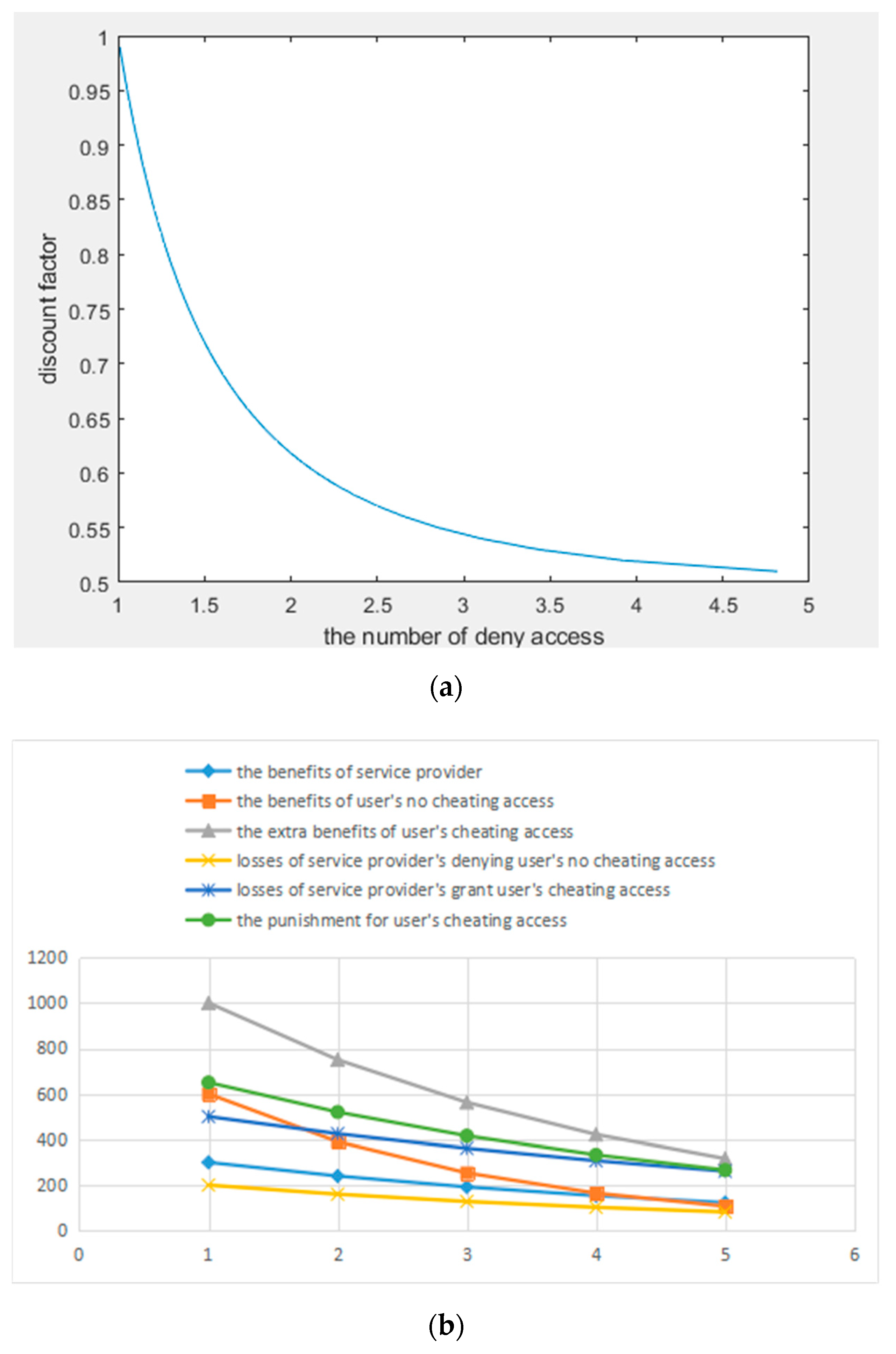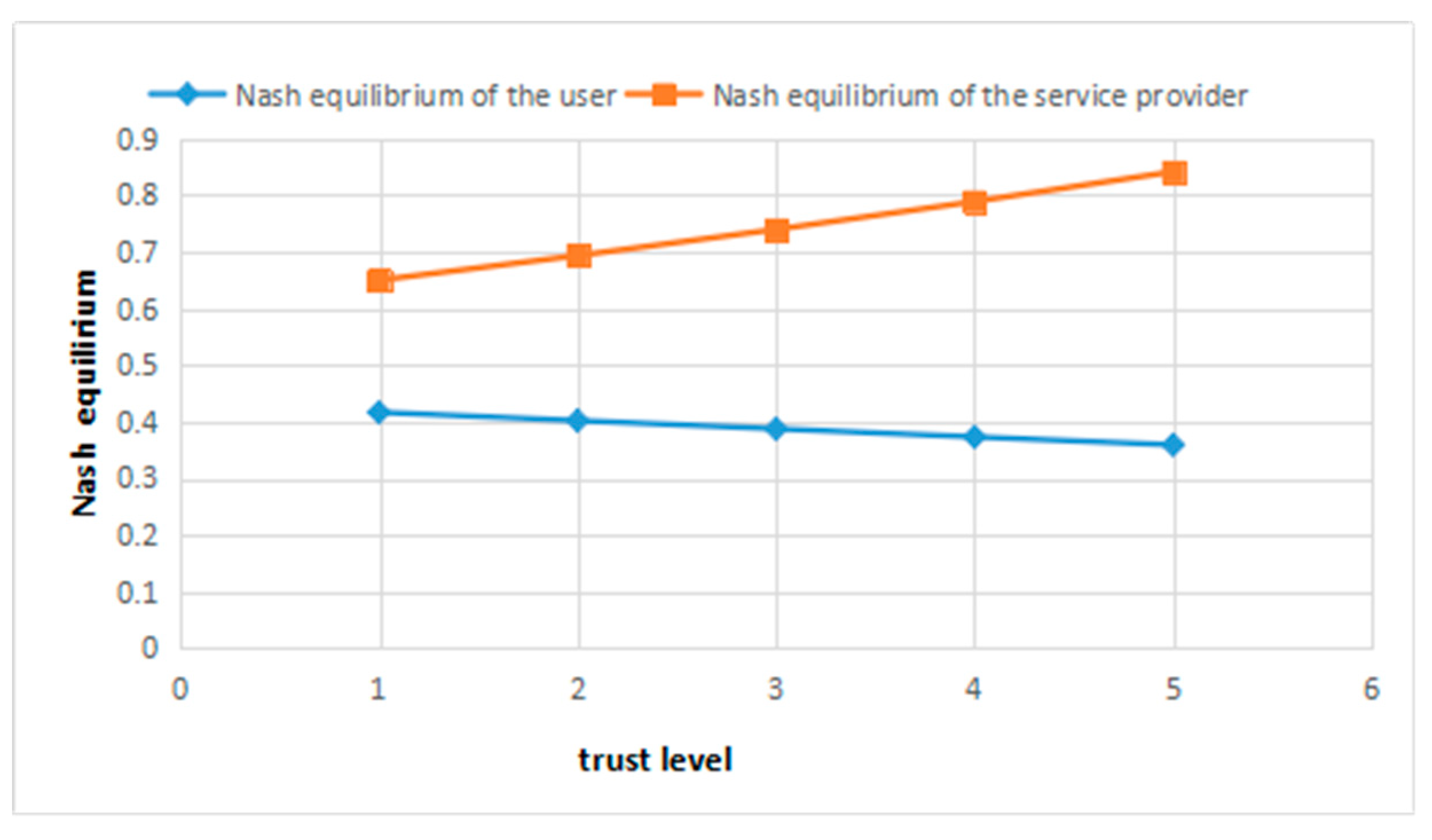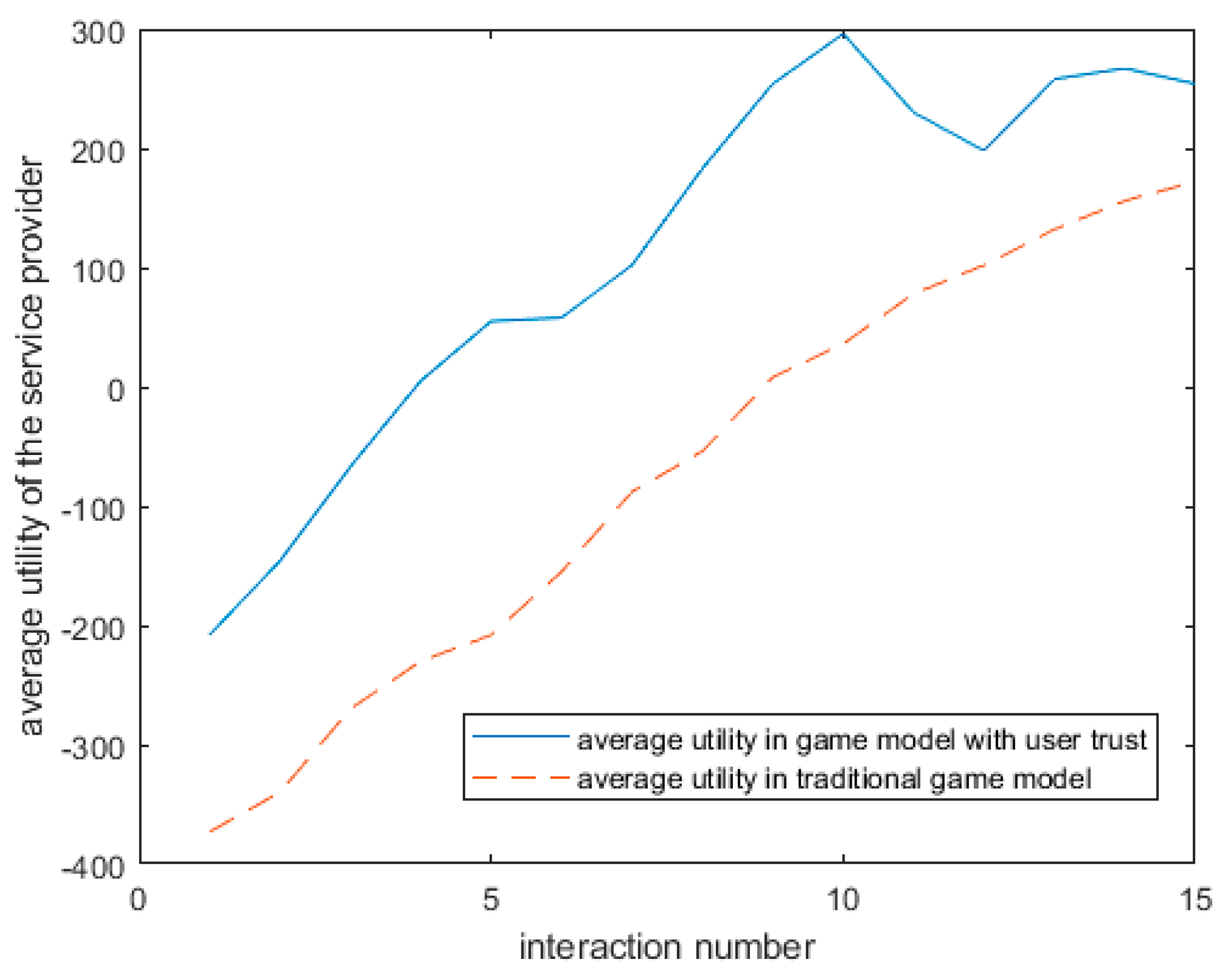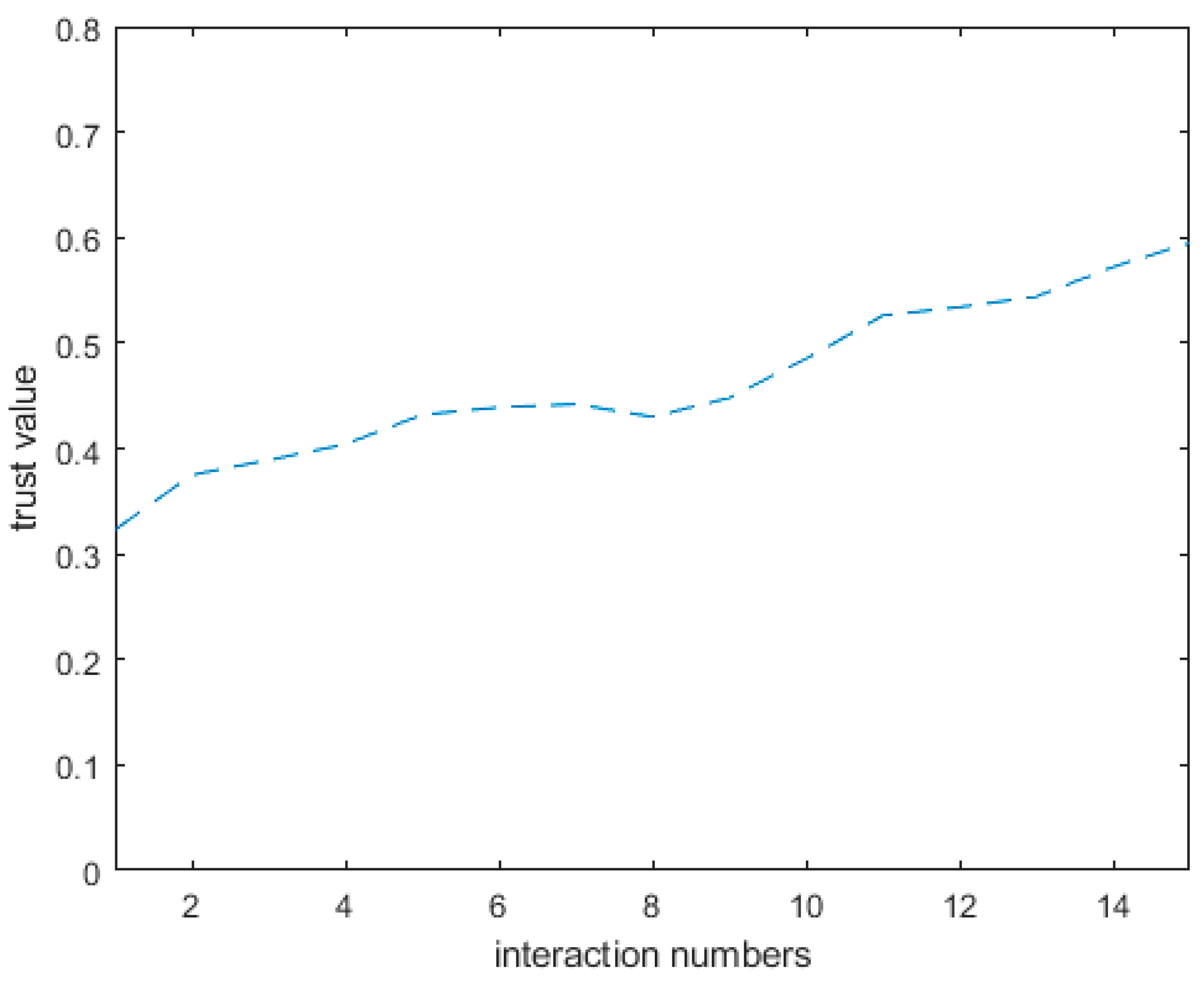Game Analysis of Access Control Based on User Behavior Trust
Abstract
1. Introduction
- We build an access control game analysis model combining with the user’s trust level, in which the trust and risk achieve unity. To the best of our knowledge, we are the first to present a utility quantification mechanism for users and the service providers, using the adaptive regulator and the user’s trust level. Then, the method of decision-making based on the Nash equilibrium of the service provider is proposed. At the same time, a solution to the prisoner’s dilemma in the traditional access control game model without user trust is also proposed in this paper.
- Due to the dynamic and vulnerable characteristics of trust, a novel trust updating mechanism that follows the principle “slow-rising and fast-falling” is proposed.
- The experiment shows that the user’s trust value presents a slowly increasing trend on the whole with the increase of interaction times. This is because our game model has potential incentive effects on the benign collaboration between the user and the service provider.
2. Related Work
3. Proposed Model
- denotes the service provider’s loss for granting the user’s cheating access. Examples are overloading the data resources or setting up proxy servers privately by the user.
- denotes the service provider’s benefits for granting user’s no-cheating access. Examples are gaining benefits by providing downloading services or enhancing a reputation through good interactions.
- denotes the service provider’s loss for denying the user no-cheating access. An example is losing the opportunity for potential long-term cooperation.
- denotes user’s benefits for no-cheating access. Examples are downloading the data resources or obtaining some knowledge in the access process.
- denotes user’s extra benefits for cheating access. Examples are overloading or setting up proxy servers privately.
- In the first game model, all of the users’ benefits are regarded as equal and different users bring the same utility to the service provider. Therefore, this game model is also regarded as the traditional access control game model. We present two kinds of solutions for the prisoner’s dilemma in this game model.
- Construct access control game model considering user trust, in which the utility of the user and the service provider are quantified using user trust level and adaptive regulatory factor , and risk is reflected in an implicit way in the utility function. Afterwards, the rational decision-making conditions for the service providers by analyzing the payment matrix is established. Finally, the user’s trust value is updated reasonably after each interaction.
4. Analysis of the Access Control Game Model Without User Behavior Trust
4.1. The Analysis of the Game Model
4.2. Presenting Two Kinds of Solutions for the Prisoner’s Dilemma
5. Constructing an Access Control Game Model with User Behavior Trust
5.1. Establishing a Payment Matrix for the Service Provider and User
5.2. Game Analysis Based on the User’s Trust Level
5.3. Decision-Making Conditions for Service Providers
6. The Update of User Trust Behavior Value
- (1)
- Rising (owing to the user’s no-cheating access),where denotes the trust value. The value denotes the maximum of the trust value, in this paper. Here denotes the factor for controlling the rate of the rise and it is a dynamic or fixed value determined by the service provider. In this paper, we set .
- (2)
- Falling (owing to the user’s cheating access),where denotes the factor for controlling the rate of falling. In this paper, we set . It is worthwhile to note that should be always be larger than because the trust value is difficult to increase but easy to decrease, which can reflect the vulnerability of trust.
7. Simulation and Example
7.1. Experimental Background
7.2. Simulation Analysis
7.2.1. The Relationship Between the Discount Factor and the Number of Denials-of-Access in the Traditional Game Model
7.2.2. Simulations in the Game Model with User Behavior Trust
8. Conclusions
Author Contributions
Funding
Acknowledgments
Conflicts of Interest
References
- Lampson, B.W. Protection. In Proceedings of the 5th Annual Princeton Conference on Information Sciences and Systems, Princeton, NJ, USA, 25–26 March 1971; pp. 437–443. [Google Scholar]
- Graham, G.S.; Denning, P.J. Protection: Principles and Practice. In Proceedings of the Spring Joint Computer Conference ACM, Atlantic City, NJ, USA, 16–18 May 1972. [Google Scholar]
- Sandhu, R.S. Lattice-based access control models. Computer 1993, 26, 9–19. [Google Scholar] [CrossRef]
- Bell, D.E.; LaPadula, L.J. Secure Computer Systems: Mathematical Foundations; The MITRE Corporation: Bedford, MA, USA, 1973. [Google Scholar]
- Sandhu, R.S.; Coyne, E.J.; Feinstein, H.I. Role based access control models. Computer 1996, 29, 38–47. [Google Scholar] [CrossRef]
- Liu, W.; Sun, Y.F. Role-based access control model and its Implementation in Operating System. Comput. Sci. 2003, 30, 254–265. [Google Scholar]
- Li, N.H.; Mitchell, J.C.; Winsborough, W.H. Design of a role based trust management framework. In Proceedings of the IEEE Symposium on Security and Privacy, Oakland, CA, USA, 12–15 May 2002; pp. 114–130. [Google Scholar]
- Chakraborty, S.; Ray, I. TrustBAC: Integrating trust relationships into the RBAC model for access control in open systems. In Proceedings of the 11th ACM Symposium on Access Control Models and Technologies, Lake Tahoe, CA, USA, 7–9 June 2006; pp. 49–58. [Google Scholar]
- Bhatti, R.; Bertino, E.; Ghafoor, A. A trust-based context-aware access control model for Web-services. In Proceedings of IEEE International Conference on Web Services. Distrib. Parallel Databases 2005, 18, 83–105. [Google Scholar] [CrossRef]
- Helil, N.; Halik, A.; Rahman, K. Non-zero-sum cooperative access control game model with user trust and permission risk. Appl. Math. Comput. 2017, 307, 299–310. [Google Scholar] [CrossRef]
- Blaze, M.; Feigenbaum, J.; Lacy, J. Decentralized Trust Management. In Proceedings of the IEEE Symposium on Security and Privacy, Oakland, CA, USA, 6–8 May 1996. [Google Scholar]
- Liang, X.; Xiao, Y. Game theory for network security. IEEE Commun. Surv. Tutor. 2013, 15, 472–486. [Google Scholar] [CrossRef]
- Manshaei, M.H.; Zhu, Q.; Alpcan, T.; Bacşar, T.; Hubaux, J.-P. Game theory meets network security and privacy. ACM Comput. Surv. 2013, 45, 25. [Google Scholar] [CrossRef]
- Roy, S.; Ellis, C.; Shiva, S.; Dasgupta, D.; Shandilya, V.; Wu, Q. A survey of game theory as applied to network security. In Proceedings of the Forty-Third Hawaii International Conference on System Sciences (HICSS), Honolulu, HI, USA, 5–8 January 2010; pp. 1–10. [Google Scholar]
- Grossklags, J.; Christin, N.; Chuang, J. Secure or Insure? A game-theoretic analysis of information security Games. In Proceedings of the 17th International Conference on World Wide Web, Beijing, China, 21–25 April 2008; pp. 209–218. [Google Scholar]
- Alpcan, T.; Basar, T. A game theoretic approach to decision and analysis in network intrusion detection. In Proceedings of the Forty-Second IEEE International Conference on Decision and Control, Maui, HI, USA, 9–12 December 2003; pp. 2595–2600. [Google Scholar]
- Zonouz, S.A.; Khurana, H.; Sanders, W.H.; Yardley, T.M. RRE: A game-theoretic intrusion response and recovery engine. IEEE Trans. Parallel Distrib. Syst. 2014, 25, 395–406. [Google Scholar] [CrossRef]
- Roos, A.; Drüsedow, S.; Hosseini, M.I.; Coskun, G.; Zickau, S. Trust Level Based Data Storage and Data Access Control in a Distributed Storage Environment. In Proceedings of the IEEE International Conference on Mobile Cloud Computing, Services, and Engineering, San Francisco, CA, USA, 30 March–3 April 2015. [Google Scholar]
- Osborne, M.J.; Rubinstein, A. A Course in Game Theory; MIT Press: Cambridge, MA, USA, 1994. [Google Scholar]
- Zhang, Y.X.; He, J.S. A Privacy Protection Model Based on Game Theory. Chin. J. Comput. 2016, 39, 615–627. [Google Scholar]
- Lin, G.Y.; He, S.; Huang, H. Access control security model based on behavior in cloud computing environment. J. China Inst. Commun. 2012, 33, 59–66. [Google Scholar]
- Bijon, K.Z.; Krishnan, R.; Sandhu, R. Risk-aware RBAC sessions. Inf. Syst. Secur. 2012, 76, 59–71. [Google Scholar]
- Díaz-López, D.; Dólera-Tormo, G.; Gómez-Mármol, F.; Martínez-Pérez, G. Dynamic counter-measures for risk-based access control systems: An evolutive approach. Futur. Gener. Comput. Syst. 2016, 55, 321–335. [Google Scholar] [CrossRef]
- Santos, D.R.D.; Marinho, R.; Schmitt, G.R.; Westphall, C.M.; Westphall, C.B. A Framework and Risk Assessment Approaches for Risk-based Access Control in the Cloud. J. Netw. Comput. Appl. 2016, 74, 86–97. [Google Scholar] [CrossRef]
- Helil, N.; Kim, M.; Han, S. Trust and risk based access control and access control constraints. KSII Trans. Internet Inf. Syst. 2011, 5, 2254–2271. [Google Scholar] [CrossRef]
- Baracaldo, N.; Joshi, J. A trust and risk aware RBAC frame-work: tackling insider threat. In Proceedings of the 17th USA Conference on Access control Models and Technologies, Newark, NJ, USA, 20–22 June 2012; pp. 167–176. [Google Scholar]
- Rontidis, G.; Panaousis, E.; Laszka, A.; Dagiuklas, T.; Malacaria, P. A game-theoretic approach for minimizing security risks in the Internet-of-Things. In Proceedings of the 2015 IEEE International Conf on Communication Workshop (ICCW), London, UK, 8–12 June 2015; pp. 2639–2644. [Google Scholar]




| Symbol | Definition |
|---|---|
| Discount factor (the extent to which future cooperation opportunities are concerned by users) | |
| M | Number of trust levels |
| adaptive regulatory factor, | |
| User’s trust level | |
| The service provider grants the user’s access request with probability of , and deny the user’s access request with probability of . | |
| User adopting no-cheating access strategy with probability of , and cheating access strategy with probability of . | |
| The threshold probability in the decision-making process | |
| User’s trust value after the interaction | |
| The control factor determining the trust reduction rate in the trust updating equation | |
| The control factor determining the trust increment rate in the trust updating equation | |
| Maximum Trust Value. We set in this paper |
| User | |||
|---|---|---|---|
| No-Cheating | Cheating | ||
| Service provider | grant | ||
| deny | |||
| User | |||
|---|---|---|---|
| No-Cheating | Cheating | ||
| Service provider | grant | ||
| deny | |||
| Trust Level | 1 | 2 | 3 | 4 | 5 | Trust Level | 1 | 2 | 3 | 4 | 5 |
|---|---|---|---|---|---|---|---|---|---|---|---|
| 300 | 240 | 192 | 154 | 123 | 700 | 595 | 506 | 430 | 365 | ||
| 600 | 390 | 254 | 165 | 107 | 1000 | 750 | 563 | 422 | 316 | ||
| 200 | 160 | 128 | 102 | 82 | 650 | 520 | 416 | 333 | 266 |
© 2019 by the authors. Licensee MDPI, Basel, Switzerland. This article is an open access article distributed under the terms and conditions of the Creative Commons Attribution (CC BY) license (http://creativecommons.org/licenses/by/4.0/).
Share and Cite
Wang, Y.; Tian, L.; Chen, Z. Game Analysis of Access Control Based on User Behavior Trust. Information 2019, 10, 132. https://doi.org/10.3390/info10040132
Wang Y, Tian L, Chen Z. Game Analysis of Access Control Based on User Behavior Trust. Information. 2019; 10(4):132. https://doi.org/10.3390/info10040132
Chicago/Turabian StyleWang, Yan, Liqin Tian, and Zhenguo Chen. 2019. "Game Analysis of Access Control Based on User Behavior Trust" Information 10, no. 4: 132. https://doi.org/10.3390/info10040132
APA StyleWang, Y., Tian, L., & Chen, Z. (2019). Game Analysis of Access Control Based on User Behavior Trust. Information, 10(4), 132. https://doi.org/10.3390/info10040132





